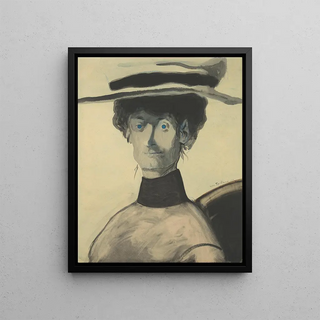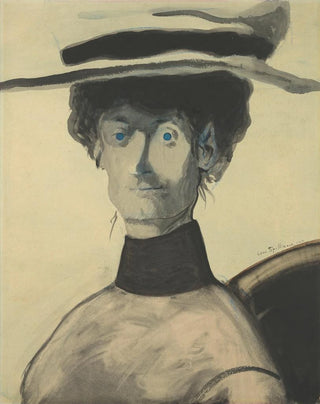Art print | Woman with pink hat - Léon Spilliaert


View from behind

Frame (optional)
Femme au chapeau rose - Léon Spilliaert – Captivating Introduction
In the fascinating world of art, some works transcend mere frames to become living witnesses of an era, an emotion, or a state of mind. "Femme au chapeau rose" by Léon Spilliaert is one of those creations that instantly captivate the viewer's gaze. Immersed in an atmosphere that is both mysterious and intimate, this painting evokes a woman whose pink hat seems to reflect a complex and nuanced personality. Through this artwork, Spilliaert invites us to explore the intricacies of human psychology while offering a poetic vision of feminine beauty.
Style and uniqueness of the work
Léon Spilliaert's style is characterized by a pursuit of introspection and pure emotion. In "Femme au chapeau rose," vibrant colors and delicate forms intertwine to create an ambiance that is both dreamlike and realistic. The color palette, dominated by soft and warm tones, gives the piece a unique luminosity. The pink hat, the centerpiece of the composition, draws the eye and becomes a symbol of elegance and femininity. The woman's facial features, both delicate and expressive, reveal a psychological depth that invites contemplation. Spilliaert skillfully plays with light and shadow, adding an almost mystical dimension to this representation. Every brushstroke seems charged with meaning, making this work a true exploration of human emotions.
The artist and his influence
Léon Spilliaert, born in 1881 in Ostend, is an emblematic figure of Belgian symbolism. His artistic training, influenced by contemporary movements, allowed him to develop a unique style where introspection and mystery occupy a central place. Spilliaert is often associated with themes such as solitude and intimacy, elements that are reflected in "Femme au chapeau rose." His work is also marked by a strong connection to nature and the surrounding environment, which translates into a particular atmosphere in his compositions. Drawing inspiration from the light of Ostend and marine landscapes, he manages to create

Matte finish

View from behind

Frame (optional)
Femme au chapeau rose - Léon Spilliaert – Captivating Introduction
In the fascinating world of art, some works transcend mere frames to become living witnesses of an era, an emotion, or a state of mind. "Femme au chapeau rose" by Léon Spilliaert is one of those creations that instantly captivate the viewer's gaze. Immersed in an atmosphere that is both mysterious and intimate, this painting evokes a woman whose pink hat seems to reflect a complex and nuanced personality. Through this artwork, Spilliaert invites us to explore the intricacies of human psychology while offering a poetic vision of feminine beauty.
Style and uniqueness of the work
Léon Spilliaert's style is characterized by a pursuit of introspection and pure emotion. In "Femme au chapeau rose," vibrant colors and delicate forms intertwine to create an ambiance that is both dreamlike and realistic. The color palette, dominated by soft and warm tones, gives the piece a unique luminosity. The pink hat, the centerpiece of the composition, draws the eye and becomes a symbol of elegance and femininity. The woman's facial features, both delicate and expressive, reveal a psychological depth that invites contemplation. Spilliaert skillfully plays with light and shadow, adding an almost mystical dimension to this representation. Every brushstroke seems charged with meaning, making this work a true exploration of human emotions.
The artist and his influence
Léon Spilliaert, born in 1881 in Ostend, is an emblematic figure of Belgian symbolism. His artistic training, influenced by contemporary movements, allowed him to develop a unique style where introspection and mystery occupy a central place. Spilliaert is often associated with themes such as solitude and intimacy, elements that are reflected in "Femme au chapeau rose." His work is also marked by a strong connection to nature and the surrounding environment, which translates into a particular atmosphere in his compositions. Drawing inspiration from the light of Ostend and marine landscapes, he manages to create






